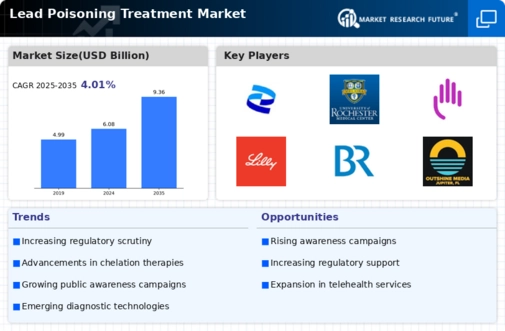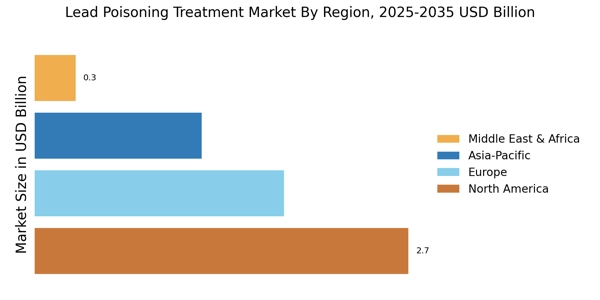Growing Awareness of Health Risks
The growing awareness of the health risks associated with lead exposure is significantly influencing the Lead Poisoning Treatment Market. Public health campaigns and educational programs have heightened understanding of the detrimental effects of lead on cognitive and physical development, particularly in children. This increased awareness has led to a surge in demand for effective treatment options, as families and communities seek solutions to address lead poisoning. Furthermore, healthcare providers are becoming more vigilant in screening for lead exposure, which is likely to drive the market further. As awareness continues to rise, the Lead Poisoning Treatment Market is poised for growth, with an emphasis on developing comprehensive treatment protocols.
Rising Incidence of Lead Poisoning
The increasing incidence of lead poisoning, particularly among children, is a critical driver for the Lead Poisoning Treatment Market. Reports indicate that millions of children are exposed to lead, primarily through contaminated water, soil, and deteriorating housing. This alarming trend necessitates effective treatment options, thereby propelling market growth. The prevalence of lead poisoning has prompted governments and health organizations to prioritize intervention strategies, which further stimulates demand for treatment solutions. As awareness of the health risks associated with lead exposure grows, the Lead Poisoning Treatment Market is likely to expand, with a focus on developing innovative therapies and preventive measures to mitigate exposure.
Advancements in Treatment Technologies
Advancements in treatment technologies are transforming the landscape of the Lead Poisoning Treatment Market. Innovative therapeutic approaches, such as chelation therapy and novel pharmaceuticals, are being developed to enhance the efficacy of lead removal from the body. These advancements not only improve patient outcomes but also expand the range of treatment options available. The integration of technology in treatment protocols, including telemedicine and digital health solutions, is further streamlining the management of lead poisoning cases. As these technologies evolve, the Lead Poisoning Treatment Market is likely to experience significant growth, driven by the demand for more effective and accessible treatment modalities.
Increased Collaboration Among Stakeholders
Increased collaboration among stakeholders is emerging as a vital driver for the Lead Poisoning Treatment Market. Partnerships between government agencies, healthcare providers, and non-profit organizations are fostering a more coordinated approach to addressing lead poisoning. These collaborations facilitate the sharing of resources, knowledge, and best practices, ultimately enhancing the effectiveness of treatment programs. Additionally, joint efforts in research and development are likely to yield innovative solutions for lead poisoning treatment. As stakeholders unite to combat this public health issue, the Lead Poisoning Treatment Market is expected to benefit from a more integrated and comprehensive approach to treatment.
Regulatory Support and Funding Initiatives
Regulatory support and funding initiatives play a pivotal role in shaping the Lead Poisoning Treatment Market. Governments and health agencies are increasingly allocating resources to combat lead exposure, which includes funding for treatment programs and public health campaigns. For instance, initiatives aimed at reducing lead levels in residential areas have led to increased investments in treatment options. This financial backing not only enhances the availability of treatment but also encourages research and development in the field. Consequently, the Lead Poisoning Treatment Market is expected to benefit from these supportive measures, fostering innovation and improving access to effective therapies.


















Leave a Comment